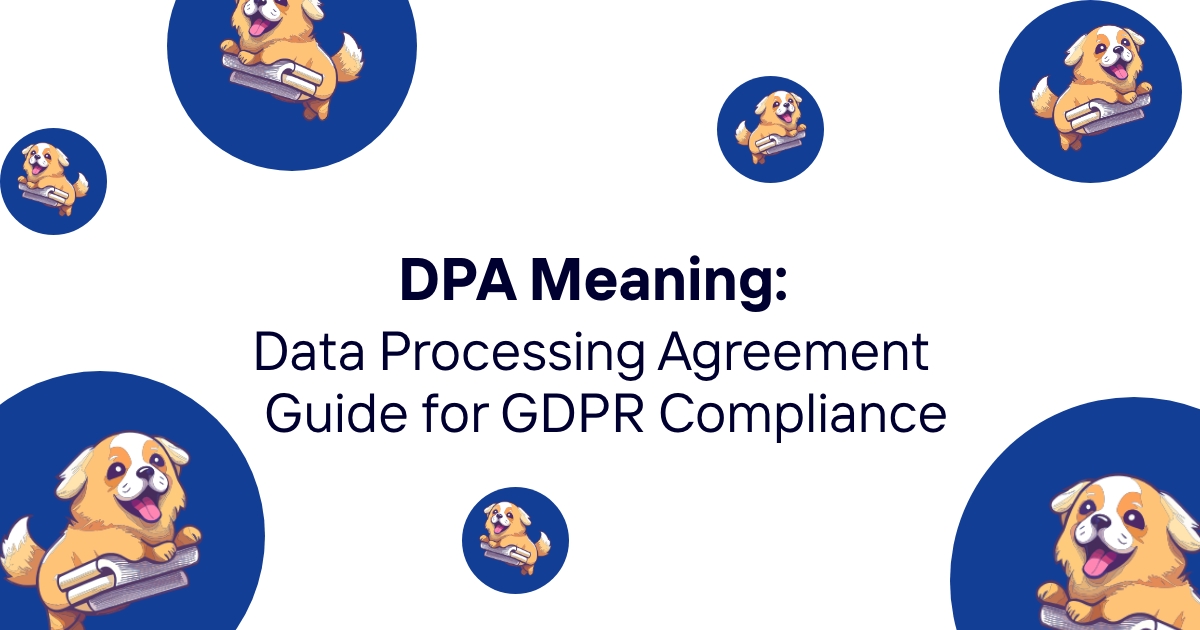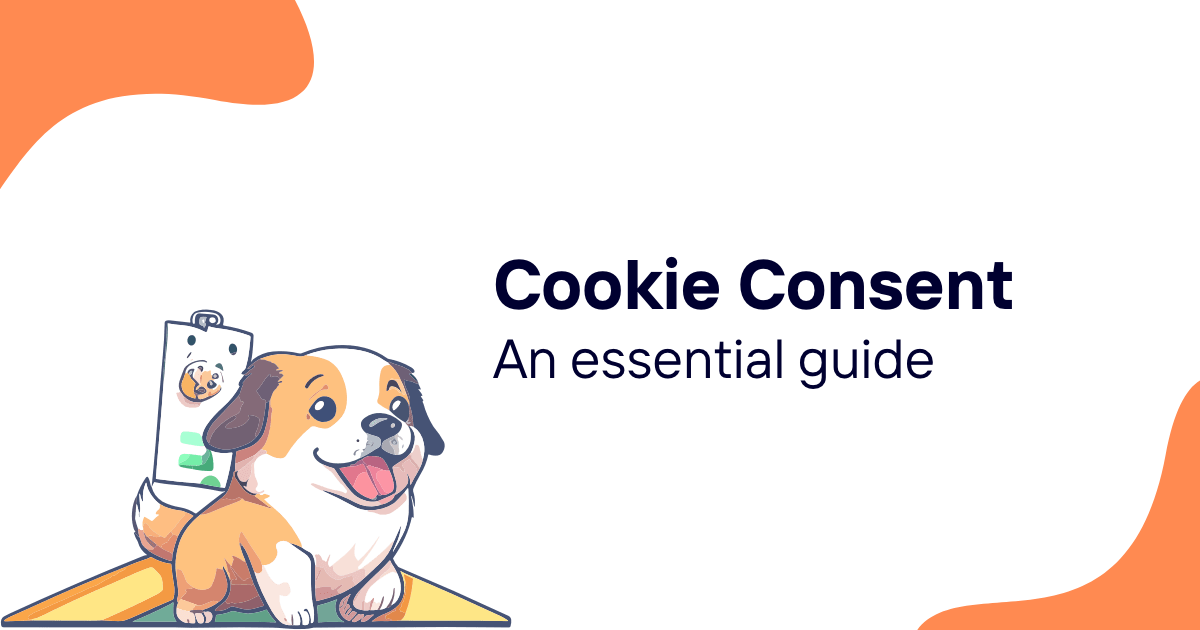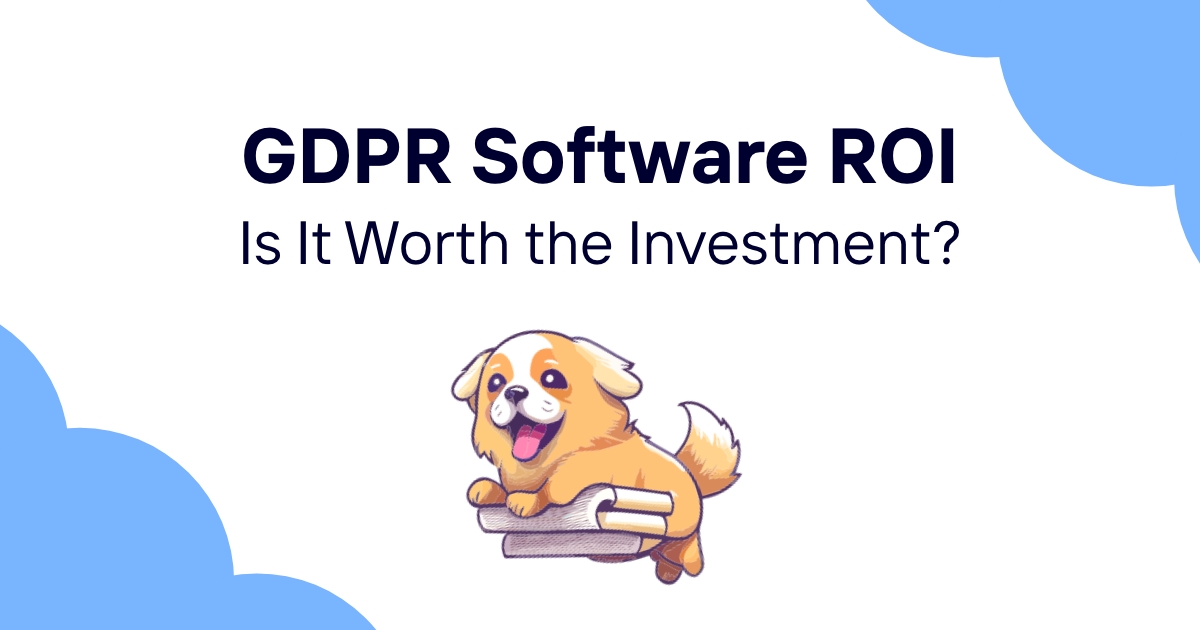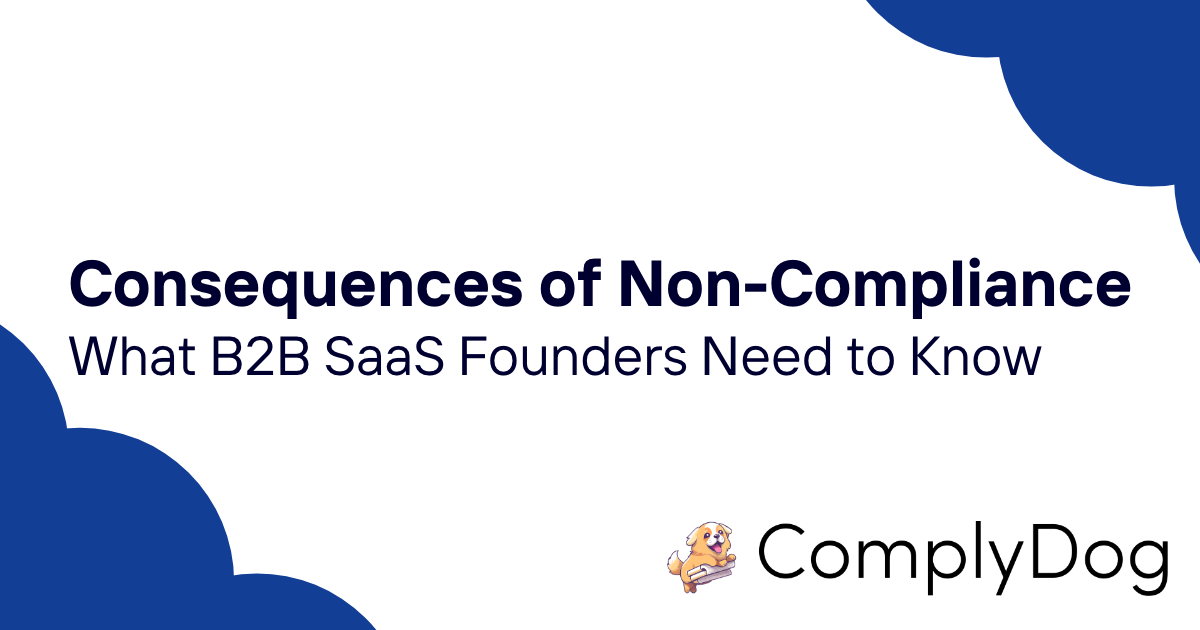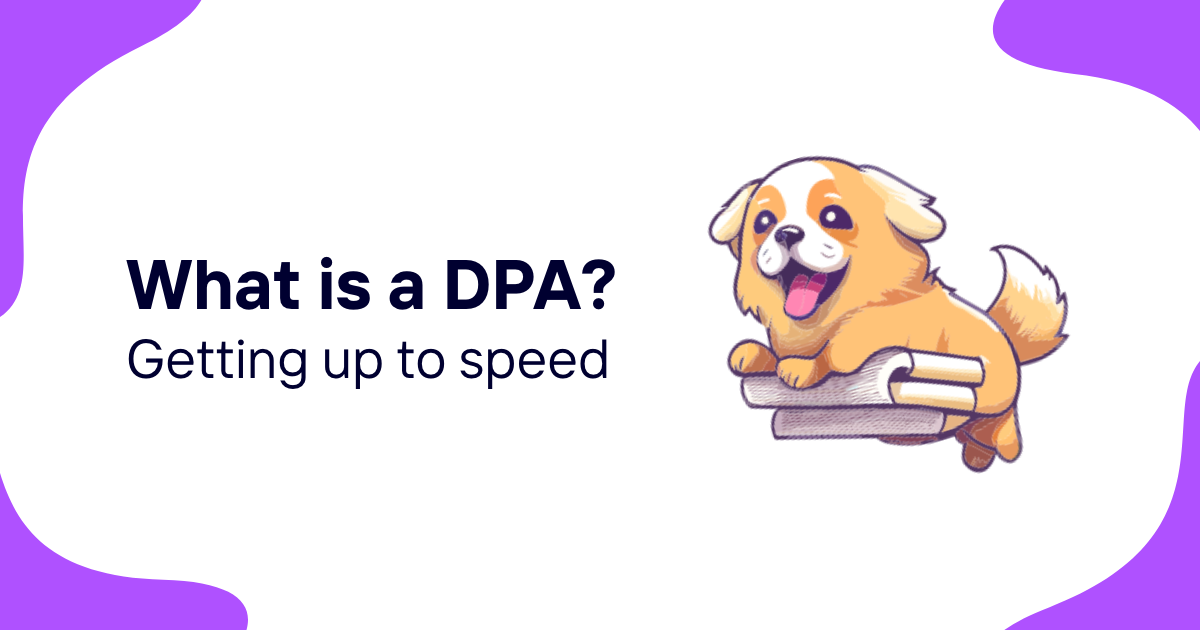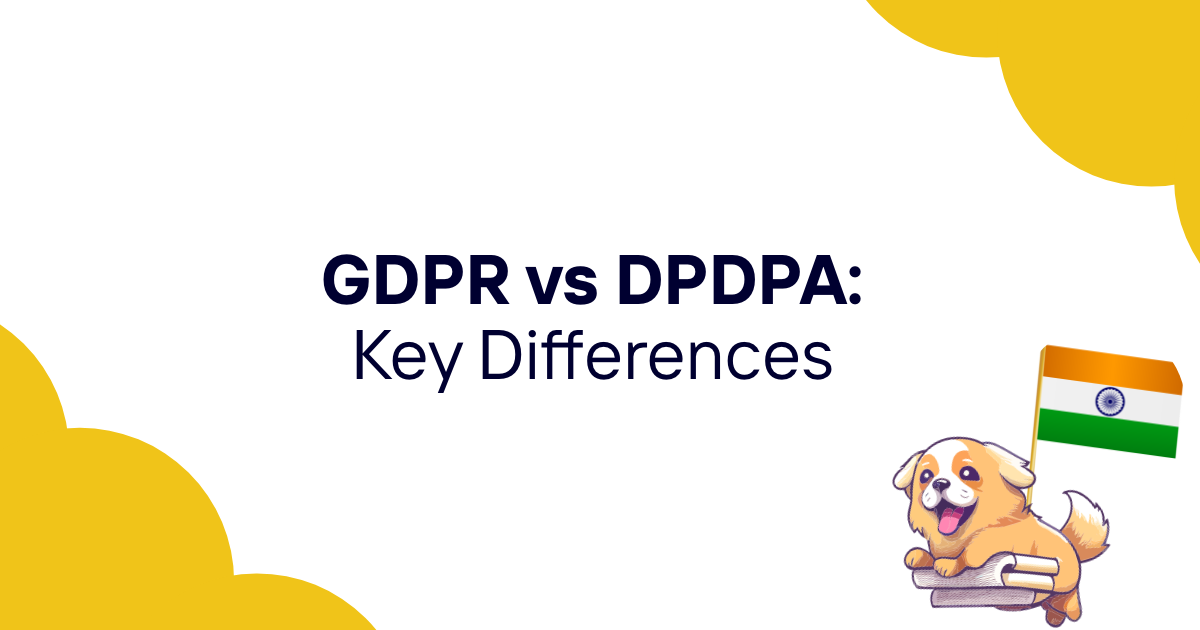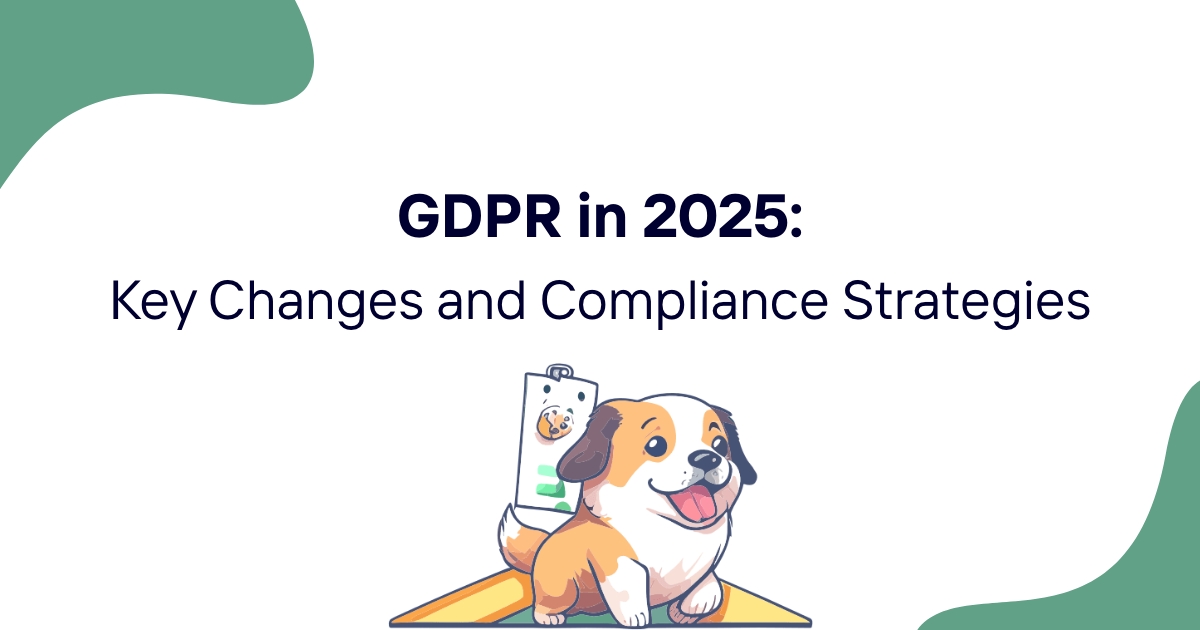Data Processing Agreements (DPAs) form the legal backbone of GDPR compliance for businesses that share personal data with third-party service providers. Understanding what DPA means and how to implement these agreements correctly can save your company from costly compliance violations and regulatory penalties.
This guide explains everything you need to know about DPAs, from basic definitions to practical implementation strategies. Whether you're creating your first data processing agreement or reviewing existing contracts, this comprehensive resource provides the guidance you need for GDPR compliance.
What Does DPA Mean? (Data Processing Agreement Definition)
DPA stands for Data Processing Agreement – a legally binding contract between a data controller and a data processor that governs how personal data is handled under the General Data Protection Regulation (GDPR).
Think of a DPA as a detailed instruction manual that tells service providers exactly how they can and cannot handle your customers' personal data. It establishes clear boundaries, responsibilities, and protections that ensure GDPR compliance throughout your business relationships.
Basic DPA Components
Every compliant DPA must include specific elements required by GDPR Article 28:
Processing Scope: Clear definition of what personal data the processor can access and the specific processing activities they're authorized to perform.
Processing Instructions: Detailed instructions about how the processor should handle personal data, including any restrictions or special requirements.
Confidentiality Obligations: Binding commitments that processor personnel will maintain strict confidentiality regarding all personal data they access.
Security Requirements: Specific technical and organizational measures the processor must implement to protect personal data.
Sub-processor Management: Rules governing when and how the processor can engage additional third parties to help with data processing.
Data Subject Rights Support: Procedures for helping the controller respond to individual rights requests like access, deletion, and correction requests.
Breach Notification: Clear timelines and procedures for reporting security incidents that affect personal data.
Data Return and Deletion: Specific requirements for returning or securely deleting personal data when the business relationship ends.
DPA vs Other Agreement Types
Understanding how DPAs differ from other business agreements helps ensure you use the right contract for each relationship:
DPA vs Service Agreement: Service agreements focus on business deliverables and performance standards, while DPAs specifically address personal data handling and privacy protection.
DPA vs Privacy Policy: Privacy policies explain data practices to individuals, while DPAs govern business-to-business data processing relationships.
DPA vs Terms of Service: Terms of service govern user relationships with your platform, while DPAs govern relationships with vendors who process personal data on your behalf.
DPA vs Business Associate Agreement: Business Associate Agreements serve similar functions in healthcare under HIPAA, while DPAs address GDPR requirements for all industries.
Legal Foundation and Requirements
DPAs derive their legal authority from GDPR Article 28, which requires written agreements for all controller-processor relationships:
Mandatory Elements: GDPR specifies minimum content that every DPA must include, making these agreements legally required rather than optional business practices.
Cross-Border Enforceability: DPAs must comply with GDPR regardless of where the controller or processor is located, as long as they process EU personal data.
Regulatory Oversight: Data protection authorities can review DPAs during compliance investigations and may impose penalties for inadequate agreements.
Individual Rights Impact: DPAs directly affect individuals' ability to exercise their GDPR rights, making proper implementation essential for compliance.
When is a DPA Required Under GDPR?
Understanding when you need a DPA helps ensure compliance while avoiding unnecessary contractual complexity for relationships that don't require these specialized agreements.
Controller-Processor Relationships
DPAs are mandatory whenever a data controller engages a data processor to handle personal data on their behalf:
Cloud Service Providers: When using cloud storage, computing, or software services that access your customers' personal data.
Marketing Service Providers: Email marketing platforms, advertising networks, and analytics services that process personal data for your campaigns.
Customer Support Platforms: Help desk software, chat platforms, and support services that handle customer communications containing personal data.
Payment Processors: Financial services that process customer payment information and related personal data.
HR Service Providers: Payroll services, benefits administration, and HR platforms that handle employee personal data.
IT Service Providers: System integrators, software developers, and technical support services that access systems containing personal data.
Identifying Processing Relationships
Determining whether you need a DPA requires understanding the specific roles each party plays in data handling:
Data Controller Role: The organization that determines the purposes and means of personal data processing. Controllers decide what data to collect, why to collect it, and how to use it.
Data Processor Role: Organizations that process personal data on behalf of and according to instructions from a data controller. Processors follow the controller's directions rather than making independent decisions about data use.
Joint Controller Situations: When multiple organizations jointly determine processing purposes and means, they may need joint controller agreements rather than DPAs.
Independent Controller Relationships: When each organization acts as an independent controller for different purposes, they typically need separate privacy arrangements rather than DPAs.
Common DPA Scenarios for SaaS Companies
Software companies frequently encounter specific situations requiring DPAs:
Customer Data Processing: When your SaaS platform processes personal data belonging to your customers' end users, you typically act as a processor requiring a DPA with your customer.
Vendor Relationships: When third-party services process your users' personal data on your behalf, you act as the controller and need DPAs with those vendors.
Integration Partners: API integrations and data sharing partnerships often create processor relationships requiring appropriate DPA coverage.
Development and Testing: Software development contractors who access production data containing personal information typically require DPAs.
As outlined in our GDPR compliance checklist, identifying all processor relationships is a critical step in building comprehensive compliance programs.
Geographic and Jurisdictional Considerations
DPA requirements extend beyond European borders based on data processing scope:
EU Data Processing: Any processing of EU residents' personal data triggers GDPR DPA requirements, regardless of where the processing occurs.
International Service Providers: US-based companies processing EU personal data need GDPR-compliant DPAs even if they don't have European operations.
Multi-Jurisdictional Compliance: Companies operating globally may need DPAs that address multiple privacy frameworks simultaneously.
Adequacy Decision Impact: The European Commission's adequacy decisions affect but don't eliminate DPA requirements for international data transfers.
DPA Key Components and Clauses
Effective DPAs require specific clauses that address GDPR requirements while supporting practical business operations. Understanding these components helps ensure your agreements provide adequate protection.
Processing Scope and Instructions
Clear definition of processing activities prevents misunderstandings and ensures compliance:
Data Categories: Specific description of what types of personal data the processor can access, from basic contact information to sensitive personal data.
Processing Purposes: Detailed explanation of why the processor needs access to personal data and what business functions they'll perform.
Processing Activities: Specific list of actions the processor can take with personal data, such as storage, analysis, transmission, or modification.
Geographic Limitations: Any restrictions on where personal data can be processed or stored geographically.
Processing Duration: Clear timelines for how long the processor can access and process personal data.
Instruction Mechanism: Procedures for the controller to provide additional processing instructions or modify existing authorizations.
Security and Confidentiality Requirements
Technical and organizational measures protect personal data throughout the processing relationship:
Encryption Standards: Specific requirements for encrypting personal data both in transit and at rest using current security standards.
Access Controls: Requirements for limiting personal data access to authorized personnel with legitimate business needs.
Authentication Requirements: Multi-factor authentication and strong password requirements for systems containing personal data.
Network Security: Firewall, intrusion detection, and other network security measures to protect personal data from unauthorized access.
Personnel Security: Background check requirements, confidentiality training, and security awareness programs for staff handling personal data.
Physical Security: Protection requirements for facilities, equipment, and storage media containing personal data.
Incident Response: Specific procedures for detecting, containing, and reporting security incidents affecting personal data.
Regular Testing: Requirements for periodic security assessments, vulnerability testing, and penetration testing.
Sub-processor Management
Many processors rely on additional service providers, creating complex chains of data processing relationships:
Prior Authorization: Requirements for controllers to approve sub-processors before they access personal data.
General Authorization: Frameworks allowing processors to engage pre-approved categories of sub-processors with notification requirements.
Due Diligence Standards: Requirements for processors to evaluate sub-processor security and compliance capabilities.
Contract Flow-Down: Obligations for processors to impose equivalent security and privacy requirements on sub-processors.
Liability Management: Clear allocation of responsibility when sub-processors cause security incidents or compliance violations.
Change Notification: Procedures for notifying controllers about changes in sub-processor relationships.
Objection Rights: Controller rights to object to specific sub-processors and require alternative arrangements.
Data Subject Rights Support
DPAs must address how processors will help controllers respond to individual rights requests:
Request Identification: Procedures for recognizing when communications from individuals constitute formal rights requests requiring response.
Data Location Assistance: Help locating all personal data associated with specific individuals across the processor's systems.
Response Timeline Support: Assistance that enables controllers to meet GDPR's strict response deadlines.
Technical Assistance: Providing data exports, corrections, deletions, or restrictions as requested by controllers.
Communication Coordination: Procedures for coordinating responses when individuals contact processors directly about their rights.
Documentation Support: Helping controllers maintain records of rights request processing for compliance verification.
As detailed in our DSAR complete guide, effective rights request processing requires close coordination between controllers and processors.
Controller vs Processor Responsibilities
Understanding the distinct roles and responsibilities of data controllers and processors helps ensure DPAs allocate obligations appropriately and enable effective compliance.
Controller Obligations and Rights
Data controllers bear primary responsibility for GDPR compliance and must ensure processors meet their obligations:
Processing Instructions: Controllers must provide clear, comprehensive instructions about how processors should handle personal data.
Processor Selection: Controllers are responsible for choosing processors with adequate security and compliance capabilities.
DPA Management: Controllers must ensure DPAs include all required elements and adequately protect personal data.
Monitoring and Oversight: Controllers must monitor processor compliance and performance throughout the business relationship.
Individual Rights Response: Controllers remain responsible for responding to data subject rights requests even when processors hold the relevant data.
Breach Notification: Controllers must notify supervisory authorities and affected individuals about data breaches, even when processors cause the incidents.
Legal Basis Establishment: Controllers must establish valid legal grounds for all processing activities performed by processors on their behalf.
Impact Assessment Responsibility: Controllers must conduct Data Protection Impact Assessments for high-risk processing activities performed by processors.
Processor Obligations and Limitations
Processors have specific obligations under GDPR that must be reflected in DPA terms:
Instruction Compliance: Processors must only process personal data according to documented instructions from controllers.
Confidentiality Assurance: Processors must ensure all personnel with access to personal data understand and comply with confidentiality requirements.
Security Implementation: Processors must implement appropriate technical and organizational measures to protect personal data.
Sub-processor Management: When engaging additional processors, primary processors must obtain appropriate authorization and impose equivalent obligations.
Assistance Obligations: Processors must help controllers respond to individual rights requests and fulfill other GDPR obligations.
Breach Notification: Processors must promptly notify controllers about security incidents affecting personal data.
Audit Cooperation: Processors must cooperate with controller audits and regulatory investigations.
Data Return/Deletion: At the end of processing relationships, processors must return or delete personal data as instructed by controllers.
Joint Responsibility Scenarios
Some business relationships involve shared decision-making that affects controller-processor dynamics:
Joint Processing Activities: When organizations jointly determine processing purposes and means, they may both be controllers requiring joint controller agreements.
Sequential Processing: Data may flow through multiple processors in sequence, creating complex responsibility chains requiring careful contract coordination.
Hybrid Relationships: Some vendors act as processors for some activities and independent controllers for others, requiring nuanced contractual approaches.
Platform Intermediaries: Multi-sided platforms may act as processors for some participants while controlling other processing activities.
Liability and Risk Allocation
Effective DPAs address how liability and risk are shared between controllers and processors:
Primary Liability: Controllers typically bear primary liability for GDPR violations, but processors can face direct penalties for specific violations.
Indemnification Arrangements: DPAs often include indemnification clauses that allocate financial responsibility for different types of compliance failures.
Insurance Requirements: Some DPAs require processors to maintain cyber liability insurance or other coverage that protects against data breach costs.
Limitation of Liability: DPAs may include liability caps that limit processor exposure while ensuring adequate protection for controllers.
DPA Templates and Examples
While every DPA should be customized for specific business relationships, starting with proven templates accelerates development and ensures comprehensive coverage.
Standard DPA Template Structure
Effective DPA templates include all required GDPR elements organized for clarity and usability:
Parties and Definitions: Clear identification of controller and processor with definitions of key terms used throughout the agreement.
Processing Details: Comprehensive description of processing scope, data types, purposes, and authorized activities.
Instructions and Limitations: Detailed processing instructions with clear boundaries on what processors can and cannot do.
Security Requirements: Specific technical and organizational measures with measurable standards and compliance requirements.
Personnel and Confidentiality: Requirements for staff training, background checks, and confidentiality agreements.
Sub-processor Provisions: Comprehensive framework for managing additional processor relationships.
Individual Rights Support: Detailed procedures for assisting with data subject rights requests.
Breach Response: Step-by-step incident response procedures with specific notification timelines.
Audit and Monitoring: Rights and procedures for controller oversight and compliance verification.
Term and Termination: Clear processes for ending the relationship and handling data return or deletion.
Industry-Specific Considerations
Different industries may require specialized DPA provisions:
Healthcare DPAs: Additional requirements for protected health information and HIPAA compliance alongside GDPR.
Financial Services DPAs: Specialized provisions for financial data protection and regulatory compliance.
Education DPAs: Student privacy protections and FERPA compliance considerations.
Government Contractor DPAs: Additional security requirements and clearance considerations for government data.
Template Customization Guidelines
Generic templates require significant customization for specific business relationships:
Risk Assessment Integration: Customize security requirements based on the specific risks associated with the processing relationship.
Business Model Alignment: Modify provisions to reflect the unique aspects of your business model and service delivery.
Technical Specification: Include specific technical requirements that match your security standards and infrastructure.
Integration Requirements: Address how the processor relationship integrates with your broader compliance program.
Legal Review and Validation
Professional legal review ensures DPA templates provide adequate protection:
GDPR Compliance Verification: Confirm templates include all required GDPR elements and meet current regulatory standards.
Enforceability Assessment: Ensure template provisions are legally enforceable in relevant jurisdictions.
Business Risk Evaluation: Assess whether template terms adequately protect your business interests and compliance objectives.
Update and Maintenance: Establish procedures for keeping templates current with regulatory changes and business evolution.
As discussed in our PII data protection guide, DPAs must address all types of personal data that processors might access, not just obvious identifiers.
Automated DPA Management Solutions
Managing DPAs manually becomes increasingly difficult as businesses grow and engage more processing partners. Automated solutions help ensure consistent compliance while reducing administrative overhead.
DPA Lifecycle Management
Comprehensive platforms manage DPAs from initial negotiation through ongoing monitoring:
Template Management: Centralized libraries of approved DPA templates that ensure consistency across all processor relationships.
Negotiation Tracking: Systems that track DPA negotiations, changes, and approvals to maintain audit trails.
Approval Workflows: Automated routing of DPAs through appropriate stakeholders for legal, security, and business approval.
Version Control: Management systems that track DPA changes over time and ensure all parties work from current versions.
Renewal Management: Automated alerts and processes for DPA renewals and updates based on contract terms or regulatory changes.
Integration Capabilities: Systems that integrate DPA management with broader vendor management and compliance platforms.
Digital Signature and Execution
Modern DPA management includes digital execution capabilities that streamline the signing process:
Electronic Signature Integration: Built-in electronic signature capabilities that enable secure, legally binding DPA execution.
Multi-Party Coordination: Systems that coordinate signature processes when DPAs involve multiple stakeholders or approval chains.
Authentication and Verification: Strong authentication requirements that ensure only authorized personnel can execute DPAs.
Document Security: Secure storage and transmission of executed DPAs with appropriate access controls and encryption.
Compliance Monitoring and Reporting
Automated systems help monitor ongoing DPA compliance and performance:
Compliance Dashboard: Real-time visibility into DPA compliance status across all processor relationships.
Performance Monitoring: Tracking of processor performance against DPA commitments and service level agreements.
Audit Support: Automated generation of compliance reports and documentation for internal and regulatory audits.
Risk Assessment Integration: Systems that evaluate ongoing risks associated with processor relationships and DPA compliance.
Scalability and Efficiency Benefits
Automated DPA management provides significant advantages over manual processes:
Reduced Administrative Burden: Automation that eliminates routine DPA management tasks and reduces manual coordination requirements.
Improved Consistency: Standardized processes that ensure all DPAs meet the same quality and compliance standards.
Faster Execution: Streamlined workflows that accelerate DPA negotiation, approval, and execution processes.
Better Oversight: Enhanced visibility into processor relationships and compliance status across the entire organization.
DPA Compliance Monitoring
Ongoing monitoring ensures DPAs remain effective and processors continue meeting their obligations throughout business relationships.
Regular Compliance Assessments
Systematic monitoring helps identify compliance issues before they become serious problems:
Quarterly Reviews: Regular assessment of processor compliance with DPA terms and security requirements.
Annual Audits: Comprehensive annual reviews of processor security practices and GDPR compliance.
Performance Metrics: Tracking of key performance indicators that measure DPA effectiveness and processor performance.
Risk Reassessment: Periodic evaluation of risks associated with processor relationships and DPA adequacy.
Incident Response Coordination
Effective DPA monitoring includes procedures for managing security incidents and compliance issues:
Incident Notification: Monitoring systems that ensure processors report security incidents within required timeframes.
Response Coordination: Procedures for coordinating incident response activities between controllers and processors.
Root Cause Analysis: Systematic investigation of incidents to identify improvement opportunities and prevent recurrence.
Compliance Remediation: Processes for addressing DPA violations and implementing corrective measures.
Documentation and Record Keeping
Comprehensive records support compliance verification and regulatory requirements:
Compliance Documentation: Detailed records of processor compliance assessments and monitoring activities.
Communication Logs: Records of all significant communications with processors regarding DPA compliance and performance.
Change Management: Documentation of DPA modifications and their impact on compliance obligations.
Audit Trails: Comprehensive records that support internal audits and regulatory investigations.
Common DPA Mistakes to Avoid
Understanding frequent DPA problems helps organizations build stronger agreements and avoid costly compliance failures.
Incomplete Scope Definition
Many DPAs fail to adequately define processing scope and limitations:
Vague Processing Descriptions: Generic language that doesn't clearly specify what processors can and cannot do with personal data.
Missing Data Categories: Failure to identify all types of personal data that processors might access during service delivery.
Undefined Geographic Scope: Lack of clarity about where personal data can be processed or stored geographically.
Inadequate Purpose Limitations: Overly broad processing purposes that give processors excessive discretion in data handling.
Insufficient Security Requirements
Weak security provisions create compliance risks and potential liability:
Generic Security Standards: Boilerplate security language that doesn't address specific risks associated with the processing relationship.
Outdated Technical Requirements: Security standards that don't reflect current best practices or emerging threats.
Inadequate Monitoring: Lack of provisions for ongoing security monitoring and compliance verification.
Weak Incident Response: Insufficient procedures for detecting, reporting, and responding to security incidents.
Poor Sub-processor Management
Many DPAs inadequately address sub-processor relationships:
Blanket Authorizations: Overly broad permissions that give processors excessive discretion in engaging additional service providers.
Inadequate Due Diligence: Weak requirements for evaluating sub-processor security and compliance capabilities.
Insufficient Flow-Down: Failure to require equivalent security and privacy protections for sub-processor relationships.
Weak Oversight: Lack of provisions for monitoring sub-processor compliance and performance.
Inadequate Rights Support
DPAs often fail to adequately address data subject rights support:
Unclear Assistance Obligations: Vague requirements for helping controllers respond to individual rights requests.
Insufficient Technical Capabilities: Lack of technical systems needed to efficiently locate and provide personal data for rights requests.
Poor Communication Procedures: Inadequate coordination processes when individuals contact processors directly about their rights.
Weak Documentation: Insufficient record-keeping about rights request processing and processor assistance.
Building effective DPAs requires understanding both legal requirements and practical operational needs. The most successful agreements balance comprehensive compliance protection with efficient business operations.
For software companies looking to streamline DPA management while ensuring comprehensive compliance, automated platforms offer significant advantages over manual contract management processes. These integrated solutions ensure consistent protection across all processor relationships while reducing administrative overhead.
Ready to automate your DPA management and ensure comprehensive processor compliance? Use ComplyDog and get automated DPA signature requests, integrated compliance monitoring, and complete processor relationship management operational immediately.
